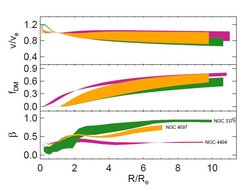Elliptical galaxies with rapidly decreasing velocity dispersion profiles: NMAGIC models and dark halo parameter estimates for NGC 4494
Lucia Morganti, Ortwin Gerhard, Lodovico Coccato, Inma Martinez-Valpuesta & Magda Arnaboldi, 2013, MNRAS, 431, 3570 (to the paper)

We present here dynamical models for NGC 4494, one of the intermediate-luminosity elliptical galaxies inferred to have an unusually diffuse dark matter halo. These axisymmetric models were obtained with the NMAGIC made-to-measure method, fitting photometric and kinematic data for different inclinations and gravitational potentials. The extended kinematic data include light spectra in multiple slitlets out to 3.5Re, and hundreds of planetary nebula velocities out to ≃7Re, thus allowing us to probe the dark matter content and orbital structure in the halo.
We carried out an extended study on how well the characteristic parameters of dark matter halos can be recovered via NMAGIC modelling of these data, using Monte-Carlo simulations on NGC 4494-like mock galaxies to estimate the appropriate confidence boundaries.
Our best-fitting models have a dark-matter fraction of 0.6 (+-0.1) at 5 Re with a 70% confidence level, and an approximately flat circular velocity curve (CVC) outside 0.5 Re. Comparing with two other quasi-Keplerian ellipticals, NGC 3379 and NGC 4697, whose velocity dispersion profiles also decrease rapidly from the centre outwards, the outer CVCs and dark matter haloes are quite similar. NGC 4494 shows a particularly high dark matter fraction inside 3Re, and a strong concentration of baryons in the centre.
